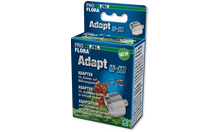Ideal nutrition for plants
Carbon dioxide serves as the main nutrient for plants and thus promotes their ideal growth. Plants use CO2 for photosynthesis and thus supply the water with essential oxygen. They prevent algae growth, remove pollutants, offer hiding places and reduce pathogens.
The correct amount of CO2 varies from aquarium to aquarium and depends on the volume, the water movement and the planting of the aquarium. With the JBL pressure reducer a precise dosage of CO2 is possible.
Easy to install
By using a size 6 Allen key (not included) the adapter can be screwed into the JBL pressure reducer. The conversion can be reversed at any time.
JBL ProFlora Adapt u-m
Adapter for the change over from disposable to refillable cylinder system
PROFLORA Adapt u-m
- Problem-free change over from disposable to refillable cylinders
- Quick and easy installation: screw adapter onto pressure reducer, finished!
- The convertion can be reversed at any time.
- Suitable for CO2 pressure reducer JBL u001
- Package contents: adapter, ProFlora Adapt u-m. Connection M10 x 1

